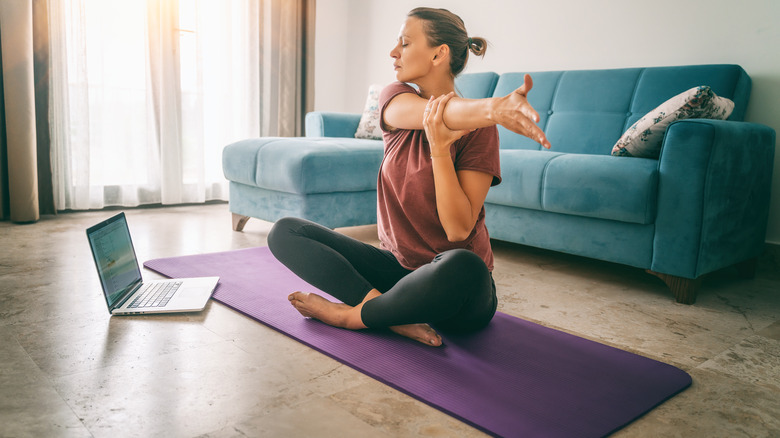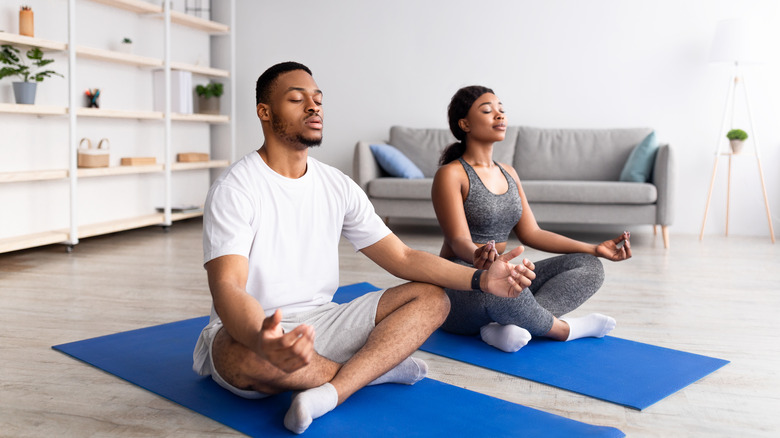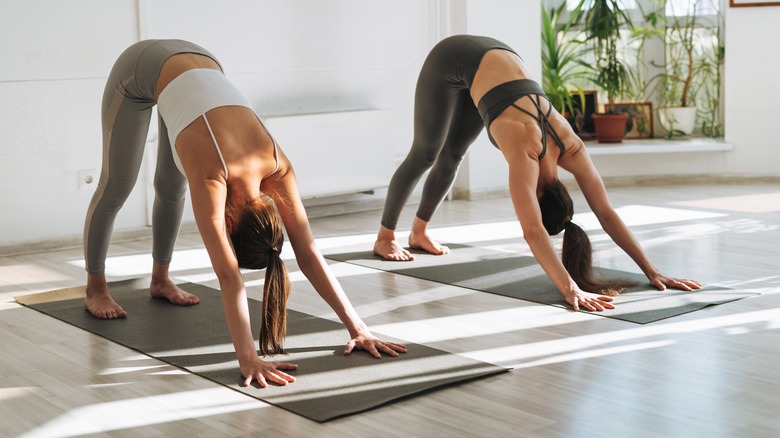What's The Difference Between Yoga And Stretching?
When conjuring an image of a person practicing yoga, you may be prone to imagining exceptional flexibility and stretching of the body into bent poses. However, while yoga does have a large stretching component to its foundation, the physical activity and spiritual practice of yoga are very different from stretching on its own, per Yoga Basics. The good news is that whether you start up a yoga practice, are already immersed in a full practice, or try to incorporate daily stretches into your schedule, both yoga and stretching share the benefits of preventing injuries, reducing pain from tight muscles and stiff joints, and improve mobility of the body.
According to Medical News Today, yoga is a practice with a history that reaches the spans of ancient eras. Though it may today be associated with the highly lucrative wellness industry, yoga has been a spiritual connection to oneself and the greater world for centuries. Yoga emphasizes the strengthening of both the physical body and the mind, which includes control over emotions and developing a relationship with one's inner being. Of course, yoga also includes a significant amount of physical movement in the form of stretching and improving flexibility. This is where differentiating yoga from stretching as an individual activity is important, particularly if you want to understand the two exercise methods and determine which one is the best for you. Here's what you should know when it comes to the basics of yoga versus the basics of stretching.
Yoga is a holistic practice
The benefits of practicing yoga are vast, ranging from increasing flexibility, mobility, balance, and strength to decreasing chronic pain and symptoms of arthritis, reports Johns Hopkins Medicine. Though a yoga class may have a mellow environment with low lighting, calm music, and aromatherapy, maintaining a regular practice of yoga has been found to lead to boosts in energy, mood, and general outlook. Since yoga deepens relaxation and encourages mental well-being, in addition to the many physical benefits, participants can experience a reduction in stress levels and ultimately improve awareness, alertness, and energy. For people who experience frequent negative feelings, anxiety, depression, or chronic fatigue, engaging in yoga consistently may play a role in decreasing negative emotional states.
Yoga has evolved over the centuries of its existence but has maintained its core tenets of balance in mind and body (via Medical News Today). There are numerous types of yoga available, like power yoga, hot yoga, and several forms that highlight maintaining correct form while holding poses for various amounts of time. In most modern yoga formats, teachings focus on developing muscular strength, flexibility, and agility, as well as breathwork and mindfulness. Yoga presents opportunities to slow down during each session, in turn providing sanctuary from the bustle of daily life. Given how ardently yoga underscores connecting with one's breathing and inner self, the practice is an exercise for both your body and mind, thus giving it a holistic framework that isn't found in traditional stretching regimens.
The advantages of stretching
The biggest difference between stretching and yoga is that stretching generally doesn't focus on mindfulness (via Yoga Basics). This isn't to say that you can't incorporate mindfulness alongside a stretching routine, especially since slow, controlled breathing can help achieve deeper stretches. If you sit for long periods of time or lack opportunities to move around, stretching is a practice that can be incorporated within small fragments of time. Whereas yoga usually involves sessions that require blocks of time, stretching can be woven into a hectic schedule in just a few minutes. The American College of Sports Medicine (ACSM) reports that stretching each major muscle group of the body for merely a minute is enough time to achieve a sufficient stretch. If holding a stretch for a full minute is difficult, the minute can be broken up into intervals of 10 to 30 seconds at a time.
Stretching can involve holding muscle groups in positions where you feel a reasonable stretch without pain, or it can include the use of accessories, such as foam rollers, myofascial release tools, and cold therapy methods (via ACSM). Beginning with a hamstring stretch after sitting for a long period of time is a good place to start, recommends Harvard Health Publishing. Regardless if you choose to practice yoga or stretching, it takes time to cultivate flexibility, and you should never place yourself in a position of pain to pursue quicker results.



